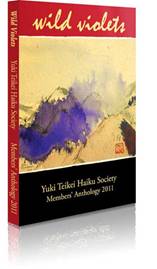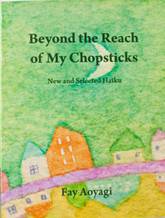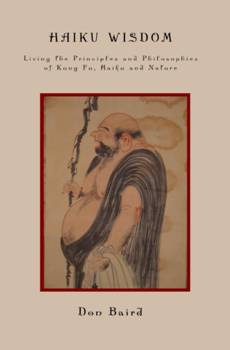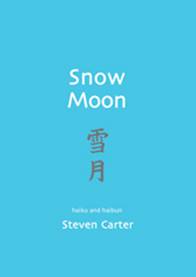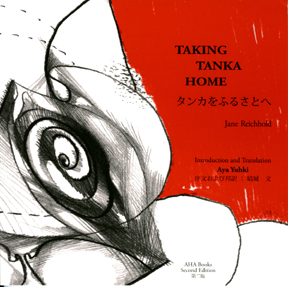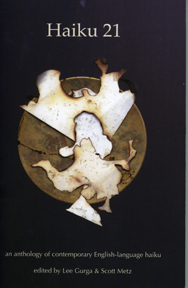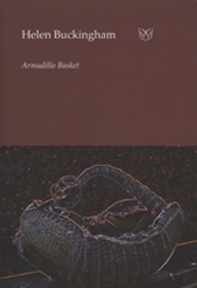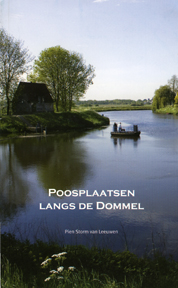|
XXVII:1 |
LYNX
A Journal for Linking Poets |
||||
|
BOOK REVIEWS
Review by Alan Summers
The anthology showcases seasonally focused haiku from its members; a summary of winners from the Tokutomi Memorial Haiku Contest (2010); haibun; and essays. Ann Bendixen’s fine interior art as folding inserts open out into larger pages that work as fine art subject dividers: a great idea, and very practical. An idea of her dramatic and effective touch of colour is shown with the full colour book covers. I would like to state that this is a most beautifully put together book by a great team, and my only regret, and worry, is that the book may have already sold out but I see on their homepage that a second printing has been authorized. Do check the Society’s home page on a regular basis, and even ask if you can get advance orders, it will sell out! So many haiku to choose from, but here are a handful: witching hour Christopher Herold
his oxygen tube Deborah P. Kolodji
spider silk Michael McClintock By way of a review I will be addressing one essay in particular as it covers a contentious subject, possibly even deemed controversial in some quarters. This Editors' Greeting that introduces the anthology includes this paragraph: The first three essays concern our core tools. Patricia J. Machmiller discusses the considerable value of the kigo. In 2010, she led several one-day seasonal workshops to study the use of the kigo in haiku. Her essay "Kigo: A Poetic Device in English Too" opens the essay section because the kigo is the bedrock of our study. Anne Homan, lead-editor of the San Francisco Bay Area Nature Guide and Saijiki (first published in 2010) shows us the importance of a saijiki (a kigo dictionary) and YTHS's process of constructing one. Deborah Kolodji addresses the ginko (the practice of writing haiku while walking).
The anthology's title is from a haiku by Patricia J. Machmiller: the little child For anyone not familiar with Patricia J. Machmiller: http://www.americanhaikuarchives.org/boardmembers/PatriciaJMachmiller.html Machmiller approaches the subject in an intelligent open manner, giving a clean clear introduction about kigo for those new or even familiar with haiku. She explains that kigo (plural and singular spelling) are devices used in haiku and renga and are symbolic of a season, and hold the power of allusion to literary, religious, and historical references. This simple statement holds a key, if not the key, to the ongoing debate whether non-Japanese writers can be allowed to use the kigo device. Kigo have had two histories, one of a poetical device that resonated deeply with writers before, during, and shortly after Matsuo Bashō, on a level that may have included a genuinely deeply felt emotional set of triggers and insights for both writers and selected readers. But which readers, of what socio-economic or cultural background? Was kigo limited to aristocratic circles and later also to the emerging and dominant merchant classes of the new middle classes? Bashō made renga and its starting verse of hokku (later to morph into haiku) more accessible, to a wider audience. But were the ordinary working class members able to be allowed access to enjoyment of haikai literature (namely renga, and standalone hokku, later haiku) and its devices including kigo? My preamble is to wonder whether the kigo was purely an academically created and driven poetic (literary) device privy to just an elite, perhaps articulated in an exclusive manner from working class people’s awareness of the natural world around them via their agrarian ties. We know that the post-agrarian society entering the industrial age had access to writing implements, and paper and card, and may have utilised seasonal words and phrases in their greeting cards and letters, as well as poetry, but were these the same as kigo, or early naïve attempts? The second history is of the increase of centralising kigo despite Japan’s different climates from the South to the North of its islands. Bureaucracy decreed that kigo became regimented, and pre-eminence given to those that related to the environs of the old capital of Kyoto, and the newly emerging capital of Edo aka current day Tokyo. Is kigo really the Japanese people’s collective consciousness, and so all non-Japanese people must be excluded? Or the secured preserve of a few? We know that hokku and haiku began to be readily available under two American actions, the mid 19th Century arrival of US black ships brokering an end to isolation for Japan and opening up of world trade; and the 1945-1952 Occupation of Japan after WWII. Japanese artists welcomed these actions and embraced Western art, which influenced haiku poetry, and of course the West were introduced to Japanese art including poetry. Why the resistance regarding haiku’s most potent tool, namely kigo, when haiku already started to absorb some Western techniques under Shiki? Would we, should we, insist that Japanese writers desist from writing Italian (or English) sonnets if they so desired? Of course not, and at least sonnets in English have been done. I wonder if the mystification of the Japanese people by Westerners is bordering on not only mistaken beliefs, as if the Japanese people were separate from all other cultures and races, but encompasses patronising characteristics which are disingenuous, and precariously close to an odd form of inverted racism. The West is a larger group of poets than ever before, and joined by those in other nations, who look to Japan’s haiku as one kind of inspiration or another. The one great strength of Japanese haikai tradition is to share, and the non-Japanese nations also share by reading each other’s work unless there is censorship imposed on them. And certainly poets since Milton have strived to read widely, and absorb widely the many methods of other poets, of anything that could inform their work. I am often reminded of Bill Manhire’s poem On Originality: http://www.nzepc.auckland.ac.nz/authors/manhire/originality.asp These last two verses sum up my own approach to poetry, where I long ago left my early misinformed isolationist stance, and fear of contamination, so common amongst many poets first starting out; where we avoid the influence by others, of whatever nation or race. It is a difficult world. We know poets concern themselves with form (or genre) with its shapes and techniques, and yet out of all forms and genres of poetry worldwide it seems there is almost an embargo on haiku with its most telling technique, that of the kigo. Where it is common practice in poetry to utilise and adapt new and old techniques from other lands, it is almost seen as verboten, and actually anti-Japanese to use kigo, and label it as such. I feel that both Bashō and Shiki would have been perplexed at this block in a poet’s attitude, and a potentially dangerous chink in their arsenal. Merely calling something a season word or a seasonal reference, if a non-Japanese writer attempts haiku, could be misleading and unfairly limiting both to writers and readers of haiku outside Japan, especially if the word(s) go beyond just the spelling out of a season. I agree with Machmiller when she says: “…I do not believe that the Japanese have a lock on kigo…” Unlike Machmiller I feel it’s time to make saijiki (the kigo dictionary) a regular actuality in countries where there occurs a large number of haiku and renga writers. This process needs to be fluid and inclusive: not an exclusive club for elite literati to dictate to lesser mortals. As well as potential new strains of inverted racism, I worry that an ongoing inverted snobbery has gone on for too long both in Japan, and in the West. Or is it misguided rose-tinted spectacles placed on a fainting goat? Machmiller states how certain words and phrases in Western culture already operate as kigo. I don’t intend to quote or reveal any more of Machmiller’s essay, as I want the anthology (in its entirety) to be part of many a haiku poet’s reference library. On a final note, it seems that the terms kigo and its partner term kidai are Post-Isolation Japan: “After haiku became a fully independent genre, the term "kigo" was coined by Otsuzi Ōsuga (1881-1920) in 1908. "Kigo" is thus a new term for the new genre approach of "haiku." So, when we are looking historically at hokku or haikai stemming from the renga tradition, it seems best to use the term "kidai." Although the term "kidai" is itself new—coined by Hekigotō Kawahigashi in 1907! Itō, Yūki. The Heart in Season: Sampling the Gendai Haiku Non-season Muki Saijiki, preface in Simply Haiku vol 4 no 3, 2006. This was originally reviewed in: Notes from the Gean Vol. 3, Issue 3 December 2011
Beyond the Reach of My Chopsticks, New and Selected Haiku by Fay Aoyagi. Blue Willow Press http://fayaoyagi.wordpress.com/ Review by Alan Summers
Fay Aoyagi’s haiku collections are a must for anyone serious about haiku, in my opinion. Fortunately for anyone who has missed out on her earlier work we have the extra bonus that her latest collection also includes a Selected Haiku section showcasing work from both of her previous collections. Aoyagi’s first haiku collection was a landmark book when it looked worryingly possible that haiku may finally, at least in English, become dried up like one of those tumbleweeds [ http://en.wikipedia.org/wiki/Tumbleweed ] you often saw in Westerns to show a town had died, become a ghost town. That’s what seemed to be the final logical outcome until books of the refreshing quality as in Chrysanthemum Love appeared. There may appear to be a lot of jockeying at present about who will be remembered as a haiku writer, outside of Japan, on a world stage level. I would suggest, whether you are new, or a seasoned reader, to haiku, to search carefully which books you add to your haiku library. If you are a writer of haiku as well, only quality reading will inform your own writing. There are few haiku writers who can harness, seamlessly, the old and the new, or can break out of a perceived mould of what a haiku should be, and what a haiku writer should be. All I can say is look out for them, and keep their books close to your side, and be particular about which haiku books build and increase your library. I have my own list of authors who I see as the real thing, and some writers know that I include them, and I am always on the lookout for new exciting writers. I have high expectations after the stop start developments of the 1990s. Although the 21st Century is still new, barely over its first decade, we need more writers of Aoyagi’s qualities to cement haiku in the West as a true tradition, and not as a strange experiment. Aoyagi is the real thing, and I urge you to beg, borrow, or steal her earlier collections, and if you are quick, you can even purchase her latest collection. Just a few of her haiku, but you’ll find yourself both reading from cover to cover, and dipping in and out. The book is a pleasure to hold and look at, and is a suitably convenient size and shape to find permanent residence in a coat pocket. low winter moon who will write plum blossoms simmering tofu– slow ceiling fan pastel-colored day A slighter longer version was originally reviewed in:
Haiku Wisdom. Living the Principles and Philosophies of Kung Fu, Haiku and Nature, by Don Baird. Modern English Tanka Press Baltimore, Maryland, 2011. ISBN 978-1-935398-25-7 A Review by Colin Stewart Jones
I did wonder how to approach this book—whether to read it as a self-help book with haiku attached or a book of haiku containing motivational teaching—the simple fact is Haiku Wisdom is both and I need not have worried—the key to its reading is to sit a while and listen to tried and tested advice, as a diligent student would. Baird is a master martial artist and an award winning haiku poet and he is, no doubt, a teacher of great merit too. Baird does not preach nor does he ask anything of his students that he has not or would not do himself, rather, he adopts the warm conversational tone of a favourite uncle. He often reminds us of the importance of play and the playground; where much of our learning is gained and to above all keep that lightness of touch – karumi – in all that we do. This is a playful book which has some seriously good advice, for anyone who would receive it, and as one would expect from a true master of Kung Fu, Baird, advocates order and discipline over fighting. Though I have never seen Baird in full fighting mode I’d bet, that if his teachings and haiku are anything to go by, he kicks ass—but I also know he’d rather talk you round first. Baird’s haiku often pose a kind of question which his prose answers. nose to nose I will not supply you with the resolution—I have purposely kept quoting from Haiku Wisdom to a minimum because it is just one of those books that you have to read to get. This is a truly unique haiku book and there is part of me that eagerly awaits the follow up but then the student in me knows that there can be no more until I have learned what has already been put to me. Haiku Wisdom may take around ninety minutes to read but there is a lifetime of teaching, contained within, to put into practice. A thoroughly recommended read!
Snow Moon: haiku and haibun by Steven Carter. Alba Publishing, Uxbridge, UK, 2011. ISBN 978-0-9551254-4-7
‘I’m in no way, shape, or form religious; and yet, and yet....’ Steven Carter is a retired emeritus professor of English and his writings have won several awards for literature. Snow Moon is his first collection of haiku and haibun and seems chiefly concerned with the writer’s search to gain some sort of understanding of his place in life. As literature students we are taught not to confuse the speaker of a poem with the author, while we can perhaps do this with his haiku, Carter’s haibun style draws heavily on his own experiences and there is no separating the man from the poetry. bathing in its own light snow moon— As the above haiku might suggest, Carter delves frequently into his family history in Snow Moon: A history which is both violent and tragic. In the haibun, Descent, he tells of his paternal grandfather’s father who killed five men in a family feud and was subsequently murdered. In, In a Day Threatening Rain, we learn Carter witnessed his mother’s death; a scene which Carter seems to revisit often in his dreams as we find in the haibun, The House. Given the above, it is understandable that Carter is searching for some meaning to it all: taking early retirement— There are, however, moments of wry humour, even if they are tinged with a certain sadness: yellows While the current holder of the title may have died he will always have a successor to take place, and on it goes. So paradoxically the world’s oldest man never dies as we are, in effect, never without one. There are poems about lymphoma and the resultant chemotherapy in Snow Moon—one wishes the author well—but the overall sense is one of numbness or rather a reluctant acceptance that the world keeps on turning: May’s new moon— Though I enjoyed his haiku, I believe Carter is more effective in his haibun: his prose style is tight and he has the knack of being sometimes informative yet still about to tap into our imagination with his choice of language. In the haibun, 1991, Carter describes Auschwitz in such graphic terms that we cannot help to be moved. Carter adopts many techniques in this final piece from Snow Moon— there is metaphor, matter-of-fact, and the downright mundane. Yet he ends with the cliché of a violin playing: in the wind There is, of course, the association to the expression where “Do you hear violins playing!” means that the person does not really give a damn. And this is perhaps the point of Snow Moon: we live, we die, and in between we suffer with no one to really empathise with us and our pain. Have you ever really told the truth to someone who has asked, how are you, and watched them baulk when they did not get the positive report that they are accustomed to? cicadas—
Taking Tanka Home by Jane Reichhold,. AHA Books 2011, second edition. Introduction and translation by Aya Yuhki. Perfect bound, 7.5 x 7.5 inches, 100 pages, Cover artwork by Werner Reichhold. Bilingual with kanji and romaji of each poem. $15 ppd. Order from AHA Books, Jane@AHApoetry.com Review by Gene Doty
Recommended Asian poetry, especially from Japan and China, have influenced American and Western poetry in many ways. Translations and advocacy by Arthur Waley and Ezra Pound were significant factors in this influence. Use of Asian forms by poets writing in English has expanded greatly in the last half-century. Japanese poets and organizations now accept tanka (and haiku) in English as legitimate uses of these forms.
Haiku 21: an anthology of contemporary English-language haiku In forms ranging from monostich to multilayer to interlinear spaces, Haiku 21 reveals a shift in haiku writing in English today. Along with typically haikuesque sensibilities come fleeting remarks, cosmic wonders, whimsies, dissonances, gritty and elegant meldings with nature, veritable koans. An eye-opening collection. —Hiroaki Sato This is the most important anthology of English-language haiku to be published in decades. If you are curious to discover how this briefest form of literature has evolved in the 21st century into a novel and potent contemporary poetics, open this book! —Richard Gilbert
Just a moment please This seems the editors' message spread with the Introduction of Haiku 21: "Come to our name-throwing, name-erasing ceremony, stay schooled and censored and follow our rules. Heaven save us from not yet occupied territories. Do not mention disjunctive methods and Jacque Derrida's seventy years old deconstructive attempts without us, the scholars of this book, who want to appear as the inventors of those and other terms. Don't jump out of the single-verse-theory into sequences; refuse mentioning more than one-hundred years old multi-genre poetry, let alone Symbiotic Arts of the western hemisphere. Do not nibble on the scented oils of long verse-text-collaborations- they may ruin kids playing in sand castles. Bury older guide books on the subject of "how-to.""
It's the late-comers' fate running contra miles of stored Arabian/Western old and contemporary poetry- right, at the world's uncountable libraries. Out of those sources it was where the Japanese in the 20th century learned and than changed their haiku-concepts- late, yes, but let's not ignore it- some did it painfully consequent. Keep an eye on the many discrepancies and twists in Haiku 21, it's probably part of a method. The editors very likely realized that it does not work in the long run but they didn't know any better right now. How about becoming your own fata-morgana and take off for a swim in your waters' verbal abilities organizing themselves? Werner Reichhold Armadillo Basket by Helen Buckingham. Waterloo Press, 95 Wick Hall, Furze Hill, Hove, East Sussex, BN3 1NG. Trade Paperback, full-color cover, 6 x 9 inches, 70 pages, £10. Contact: waterloopress@hotmail.co.uk
As you can see, this professionally made cover with an intriguing illustration should tempt any buyer of poetry books. It is faithfully within the current fashions for books of serious poetry and yet I am mystified, however, by seeing the author’s name so large and at the top and then Armadillo Basket, the title, so much smaller in thin italics below. Dad’s shed I can see how a basket could be made from the shell of an armadillo but cannot remember actually seeing one. (Note: I have now spent 1 ½ hours googling and surfing and now know more than I wish to about ‘dillos – more time than given to reading the book.) That’s okay. I am all for new images in haiku and for any idea enlarging my horizons. Helen Buckingham’s poems set me to thinking about old haiku writers and yet, here is Helen – still so young. We who have stacks of moldering haiku notebooks are on the look-out for new subject matter and yet here is some too young and too new to haiku who has leaped over the miles of ink we spent in writing ourselves beyond our desire to imitate the Japanese to start where we have worked so hard to get. Kudos to Helen! Season’s Greetings The Old Fox. . . the umpteenth bitter
I do hope you will buy a copy of this book and read it to see if I am totally wrong about her. I hope you can encourage her to become the English Machi Tawara. Write to tell me where to spread my ashes. evening See? It is so simple. Why can’t you do it like that?
Among the books still laying on my desk, still waiting for a book review, there is this one. Yes, it is written in Dutch and I can only understand about one in five Dutch words but that is not important. What is important is what one community in Holland is doing for its local poets. I have mentioned the program by Pien Storm von Leeuwen, thanks to the materials and the translations by Silva Ley aka J. van Aeist-Versteden. Pien Storm von Leeuwen, a poet and artist initiated an art project in which local poets would have their poems carved in stones which would be placed in resting spots along the local river – the Dommel. Not content with that, he went on to organize the photographer, Jan Willem Sturm van Leeuwen. to create a set cards about the poems and where they are placed. Not content with that action, he now has published this book, Poosplaatsen Langs De Dommel. Yes, the book is small, but the pictures are marvelous. If you have ever been to Holland, this book will, within a page or two, transport you back there. If you have never had this experience, then the romantic, rustic photos of this book will make you want to see these places for yourself. The poem from Silva Ley is: Trees and towers everywhere That does need to be held fast by a big fat rock along the river! Wake up world and plant the poems in lovely places.
BOOK NOTES Vic Gendrano's new book announced: Steve Holtje wrote a book review of Breasts of Snow: Tanka and Life of Fumiko Nakajo translated by Hatsue Kawamura and Jane Reichhold.
| |||||
BOOK REVIEWS Wild Violets, Yuki Teikei Haiku Society Members’ Anthology 2011 Edited by Jerry Ball and J. Zimmerman ISBN 978-0-9745404-9-8. YTHS: www.youngleaves.org Review by Alan Summers Beyond the Reach of My Chopsticks,
New and Selected Haiku by Fay Aoyagi Review by Alan Summers
Snow Moon: haiku and haibun by Steven Carter. Alba Publishing, Uxbridge, UK, 2011. ISBN 978-0-9551254-4-7 Taking Tanka Home by Jane Reichhold,. AHA Books 2011, second edition. Introduction and translation by Aya Yuhki. Perfect bound, 7.5 x 7.5 inches, 100 pages, Cover artwork by Werner Reichhold. Bilingual with kanji and romaji of each poem. $15 ppd. Order from AHA Books, Jane@AHApoetry.com Review by Gene Doty Haiku 21: an anthology of contemporary English-language haikuedited by Lee Gurga & Scott Metz, with an introduction by the editors. Perfectbound, 205 pages: over 600 haiku by more than 200 poets, Modern Haiku Press, 2011 (Lincoln, IL) ISBN: 978-0-974189-45-1. Armadillo Basket by Helen Buckingham. Waterloo Press, 95 Wick Hall, Furze Hill, Hove, East Sussex, BN3 1NG. Trade Paperback, full-color cover, 6 x 9 inches, 70 pages, £10. Contact: waterloopress@hotmail.co.uk
BOOK NOTES Poosplaatsen Langs De Dommel Vic Gendrano's new book announced: Steve Holtje wrote a book review:of Breasts of Snow: Tanka and Life of Fumiko Nakajo translated by Hatsue Kawamura and Jane Reichhold. |
|||||
Back issues of Lynx: |
Next Lynx is scheduled forJune, 2012.
Send to: Werner@WernerReichhold.com | ||||
